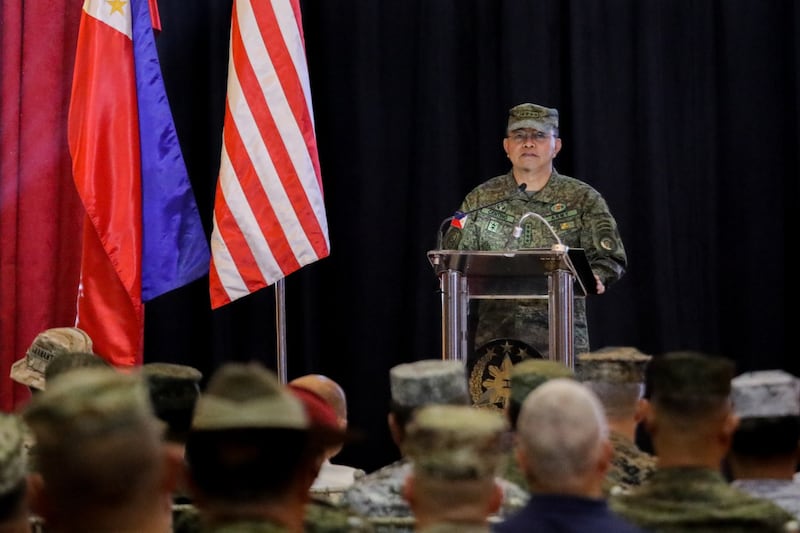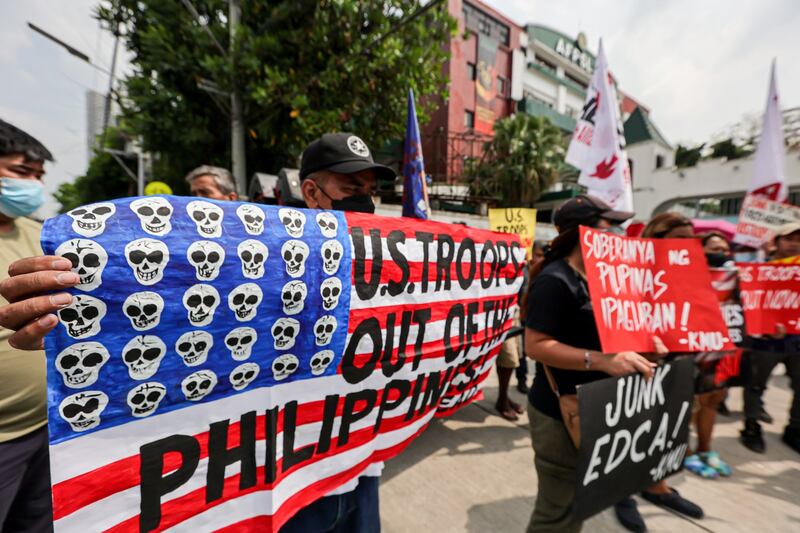UPDATED at 6:55 p.m. ET on 2023-04-11
Treaty allies the United States and the Philippines kicked off their biggest-ever annual joint military exercises on Tuesday, amid growing regional tensions between the U.S. and China over Taiwan and anti-American protests by Filipinos.
Meanwhile, the top diplomats and senior most defense officials of the two nations held a five-hour meeting at the Department of State in Washington, addressing “evolving regional and global security challenges,” among other topics.
The Balikatan Exercise 2023 brings together 17,680 troops – an estimated 12,000 Americans, 5,000 Filipinos, and more than 100 Australians – who will participate in live-fire drills and other activities until April 28.
"Balikatan," which means "shoulder to shoulder" in Tagalog, got underway a day after Philippine President Ferdinand Marcos Jr. sought to allay public fears that a beefed-up American military presence here would unnecessarily draw the Southeast Asian country into a conflict in case China attacked Taiwan.
Gen. Andres Centino, the Philippine military’s chief of staff, said the drills would not only bolster bilateral ties but “contribute to peace and stability in the Indo-Pacific region in a definitive manner.”
Among the drills on the program are a command post exercise, which aims to strengthen the allies’ ability to plan, coordinate, and provide command-and- control of forces against a range of scenarios and simulated challenges.
And during this year’s Balikatan, participants for the first time will carry out a live-fire training with Patriot missiles and Avengers air-defense systems, which Ukraine has used against invading Russian forces.
In a live-fire exercise at sea, Filipino and American troops will target and sink a 200-foot-long mock enemy vessel in the waters off Zambales province, in a part of the South China Sea that lies within Manila’s exclusive economic zone. Beijing and Manila, as well as other Southeast Asian countries and Taiwan, have overlapping claims in the strategic waterway.
Another new component of the war games this year is cyber defense.
“All these major events are intended to ensure the achievement of the end state of our Balikatan 2023 exercises, which is to fully develop mutual defense capabilities to enhance cyber defense operation and strengthen the country’s maritime security and domain awareness,” Centino said in a speech Tuesday inaugurating the drills.
The two countries are bound by a Mutual Defense Treaty to assist one another in case of an armed attack on either of their armed forces, or aircraft or public vessels, anywhere in the South China Sea, a point U.S. Defense Secretary Lloyd Austin reiterated in Washington.
During the third U.S. Philippines 2+2 Ministerial Dialogue the two sides discussed plans to conduct “combined maritime activities with like-minded partners in the South China Sea later this year,” Austin told a press conference following the meeting.

And a joint statement voiced strong objections to China’s repeated massing of maritime militia ships inside Manila’s exclusive economic zone, as well as new reports of Beijing’s “covert land reclamation on unoccupied features in the Spratly Islands.”
The two nations also agreed to accelerate implementation of EDCA projects, the statement said, referring to a controversial plan to grant U.S. forces access to four more Philippine bases under an expanded defense pact, as tensions build between China and Taiwan.
On Monday, Marcos tried to calm jitters and criticism among Filipinos about his administration’s decision, saying Americans would use the newly selected locations to preposition equipment that they could readily access in times of natural disasters.
“Now, the reaction of China is not really surprising because they worry too much. But … the Philippines will not allow the bases to be used in offensive action. The bases are only to help the Philippines if the country needs help,” Marcos told reporters on the sidelines of an event honoring Filipino war veterans.
Three of the four bases are located on the main and northernmost Philippine island of Luzon, including two sites that face Taiwan. A fourth site, in Palawan province, faces the South China Sea where territorial tensions between China and the Philippine have been high in recent years.
This largest iteration of the Balikatan drills began a day after the Chinese military concluded three days of maneuvers and war games around Taiwan, including simulated precision strikes. China launched the drills as a response to Taiwanese President Tsai Ing-wen's visit to the United States early this month, where she met with U.S. House Speaker Kevin McCarthy.
The unprecedented meeting on U.S. soil further angered China, which also expressed its displeasure over the Marcos administration’s move to grant the U.S. access to other bases in the Philippines.
“The U.S. military has been coming all the way from the other side of the Pacific to stir up trouble in the South China Sea and ganging up with its allies from other parts of the world to flex muscle,” the Chinese Embassy in Manila said in a March 12 statement.
The U.S. has heightened tensions, driven a wedge between China and the Philippines, and “upset the joint effort of countries in this region to safeguard peace and stability in the South China Sea,” it alleged.
Opposition to war games
Meanwhile on Tuesday, Philippine activist groups held protests outside Camp Aguinaldo and the U.S. Embassy in Manila to express their opposition to the joint military drills in different parts of the country and the expanded access for U.S. forces at local bases.
“The Philippines is ours. U.S. get out of our country!” some protesters chanted outside the military’s headquarters in Quezon City.
In a separate statement, the anti-U.S. International League of Peoples’ Struggle (ILPS) said the Balikatan exercises were “nothing but a blatant display of U.S. imperialism’s military intervention and aggression in the country and region.”
“The presence of foreign troops in local communities poses a grave threat to safety, security, and welfare of the people. We have witnessed how these exercises have resulted in environmental destruction, displacement of indigenous peoples and peasants, sexual abuse and exploitation of women and children, extrajudicial killings, torture, harassment, and intimidation of activists and critics,” ILPS chairman Len Cooper said in a statement on Monday.

A fisherfolk group also criticized a no-sail zone policy being enforced during the military drills in at least five towns in Zambales, as the exercises coincide with the peak fishing season from February to May. The coastal towns affected are San Antonio, San Narciso, San Felipe, Cabangan, and Botolan.
“What difference does the United States make to China when it comes to disrupting the livelihood of Filipino fishers in the West Philippine Sea? The Filipinos do not deserve to be displaced from their livelihood only to provide a security blanket to foreign forces carrying out war games accompanied with live-fire exercises in our fishing grounds,” said Bobby Roldan, vice chairperson for the Luzon chapter of Pamalakaya.
Basilio Sepe and Gerard Carreon contributed to this report from Manila.
This report has been updated to include details about the five-hour meeting of defense and foreign affairs officials in Washington.
BenarNews is an RFA-affiliated news organization.
